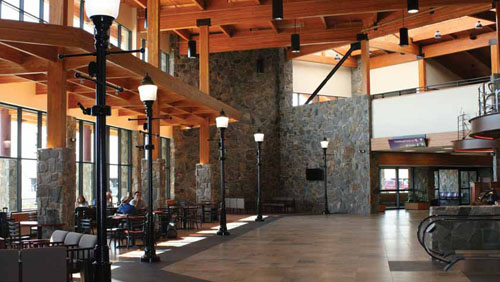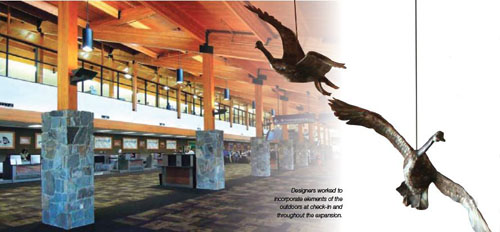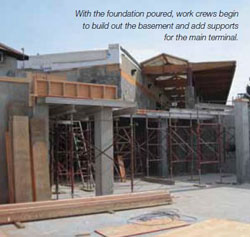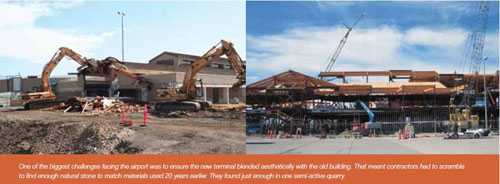Gallatin Field Unveils Stone & Wood Expansion


Surrounded by miles of pristine forest and towering mountains, Gallatin Field Airport (BZN) in Bozeman, MT, is the largest commercial airport serving Yellowstone National Park and several major ski resorts. Its recent $40 million terminal expansion, constructed of quarried rock and natural wood beams, is a testament to the area's distinctive outdoor culture.
BZN's position as the gateway to a treasured national landmark, however, doesn't make it immune to the nation's current economic challenges. "We needed to raise $16 million in revenue bonds to complete the expansion, and we wondered if it would work out during the recession," recalls airport director Brian Sprenger. "But we got a good interest rate and sold them all."
The airport also contributed $3 million it had generated over the last several years and plans to repay the bonds through increased passenger facility charges, adds Sprenger. FAA funds provided $18.5 million for the project, and stimulus money from TSA added another $2.5 million. The airport's rental car companies contributed the remaining $2 million.
 "It took a leap of faith to attempt a project of this size during a major recession," Sprenger reflects. "We knew we had to expand the terminal, so we had been banking a lot on AIP funding and had fairly good cash reserves at the start."
"It took a leap of faith to attempt a project of this size during a major recession," Sprenger reflects. "We knew we had to expand the terminal, so we had been banking a lot on AIP funding and had fairly good cash reserves at the start."
According to project planners at Reynolds, Smith and Hills (RS&H), the $40 million terminal expansion that began in 2010 was the largest single airport project in Montana history. With four additional gates, a new passenger checkpoint and upgrades to ticketing, baggage screening and baggage claim, BZN's newly expanded terminal is expected to serve the airport for at least 40 years. In addition, it's designed to accommodate another six gates should the airport need to expand capacity again.
Organic Growth

After 40 years of consistent passenger growth, the upward trend at BZN is projected to continue, notes Sprenger. In 2000, the airport enplaned about 240,000 people; this year, it will enplane nearly 400,000 - a record high.
 Sprenger attributes a 6% increase in passenger traffic between 2009 and 2010 to the addition of two low-cost carriers: Horizon Air and Frontier Airlines. "Because Montana has always been a destination for leisure travel, the local economy has seen less impact from
Sprenger attributes a 6% increase in passenger traffic between 2009 and 2010 to the addition of two low-cost carriers: Horizon Air and Frontier Airlines. "Because Montana has always been a destination for leisure travel, the local economy has seen less impact from
|
factsfigures Project: Terminal Expansion Location: Gallatin Field Airport, Bozeman, MT Size: 200,000 sq. ft. Cost: $40 million Funding: FAA -$18.5 million; TSA - $2.5 million; Rental Car Companies - $2 million; Internal Funding & Bond Sales - $19 million Completed: Aug. 2011 Master Plan: Reynolds, Smith and Hills; Morrison-Maierle Construction Manager: Martel Construction Principal Architect: Prugh & Lenon Engineer: Morrison-Maierle Wayfinding Signage, Public Address System Installation, IT Networking, Boarding Bridge Specifications & Concession Area Design: Reynolds, Smith and Hills Information Displays: Infax Boarding Bridges: Jetway Systems, by JBT AeroTech Benefits: Increased terminal size, additional concessions on secure side & increased baggage processing efficiency. Noteworthy Detail: Construction manager at risk process allowed crews to begin work on some areas while other sections were still being designed. Unique Challenge: Only one active quarry still in operation producing stone to match the original terminal |
 Increased traffic despite the overall economic downturn forced BZN to rethink its 20-year-old master plan. The Gallatin Airport Authority engaged RS&H to provide project planning and help create a new master plan with Morrison-Maierle, the firm that also completed the structural engineering for the expansion.
Increased traffic despite the overall economic downturn forced BZN to rethink its 20-year-old master plan. The Gallatin Airport Authority engaged RS&H to provide project planning and help create a new master plan with Morrison-Maierle, the firm that also completed the structural engineering for the expansion.
In addition to providing master planning services, RS&H developed wayfinding signage for the new terminal, installed the public address system and networked the airport's information technology system. It also drafted specifications for the passenger boarding bridges and designed concession areas.
Creating a plan and construction documents that could adjust to economic fluctuations was key, recalls Michael Spitzer, building service group leader for RS&H's Northwest region. "As the economy went up and down over the past four years, our plan had to be scalable so that if bids were favorable, we could act on the next level and then the next level in order to incrementally expand," Spitzer explains.
Montana Motif
Scott Bell, vice president of the airport market for Morrison-Maierle Engineering, describes the design of BZN's new terminal as a cross between the old West and the great outdoors. "The terminal building fits in well with the ambiance of Montana," says Bell.
The natural materials used to build the new 200,000-square-foot terminal create an outdoorsy flavor that permeates the airport, including its gate monitors and website. Architects from Prugh & Lenon built on the visual themes of their previous projects at BZN, including the airport's first addition 20 years ago and a control tower and new airport safety building.
"We inherited a building with a strong character as depicted in the use of stone and wood," relates Jamie Lenon, vice president of Prugh & Lenon. "The old building expressed a natural environment that showcased what Montana was all about, and there was strong opinion within the airport authority and the Bozeman community that the new terminal must maintain that iconic style."
That proved to be challenging for several reasons. First, the addition greatly increased the building's proportion, which required more depth in the lobby and concourse. "We made an effort to blend the new terminal into the existing architecture," says Lenon, noting that only a small portion of the original building (an area that housed rental car operations) had to be destroyed. Having the rental car offices located in the baggage lobby rather than in trailers outside the terminal during construction, however, ultimately proved to be a benefit.
"We worked hard to take a beautiful building, double it and maintain that same level of beauty in proportion and style," Spitzer adds. "The end result was spectacular."
Finding enough of the stone used to create the original 1977 terminal for the recent expansion was challenging, but critical to aesthetically blend the two structures. The stone came from what is now Forest Service property, and the agency no longer allows rock to be quarried on public land, explains Lenon.
 |  |
Designing the utilities and mechanical systems was another key challenge, because the expansion tripled the size and scope of the airport's existing data, mechanical and electrical systems.
Perhaps the biggest challenge, though, was a human factor: retraining airport visitors to follow an entirely new traffic pattern.
"Because the airport could only expand to the west, we had to completely reverse traffic circulation so that departures were dropped off on the left side and arrivals were met on the right," explains Lenon. "It is completely opposite of the typical way airports control traffic."
Construction crews were under pressure to keep the project on time to accommodate flights that were scheduled by airlines months before completion.
"We had to be ready to receive the first planes scheduled to come in, and we had to make sure there was space to put those planes," recalls Spitzer. Sprenger, he adds, helped the process by meeting the needs of airlines, passengers, vendors and construction crews.
"Even the building tenants did their part to make sure the project came in on time and within budget," he notes. "Each tenant was responsible for wiring up their part of the building. TSA had to deliver passenger screening equipment and make sure the components were installed and tested on time."
Cool It
To help the airport conserve energy, engineers created a unique cooling system that pulls cold groundwater out of two supply wells at a rate of 5,000 gallons per minute and directs it through a heat exchanger that cools air for the terminal. "When it is 75 to 80 degrees outside, the system works very well using 50-degree water to cool the building," Sprenger explains.
After the water's cool properties are harnessed, it is pumped back into the ground. Although chillers are no longer needed, the previous cooling units were left in place for backup.
Based on a dramatic decrease in energy needed for air conditioning, the airport is expecting payback for the new system in three to four years, reports Lenon.
New Communications System
Infax developed BZN's new information displays, including gate screens, baggage claim displays and ticket counter screens. A visual paging system, which relays textual messages to passengers, was also incorporated into flight monitors located throughout the airport.

The company, which once considered building bulky cathode ray tube television displays its bread and butter business, now serves airports as general information technology integrators, relates Frank Steele, a software product engineer with Infax.
In the past, rack-mounted computers controlling airport screens were located in a closet or communications room, Steele recalls. They required additional power and cooling as well as a video extender to ensure strong video signals. With new integration, he contrasts, airports no longer need video extenders to push signals to the screens, and LCD screens now have embedded controllers mounted onto a single-board computer. If the controller fails, a technician can loosen two screws and pop in a new unit.
"The image looks sharper, because it offers full high-definition resolution," says Steele. "Bozeman was the first airport at which we rolled out the new displays."
Infax designed the monitor screens with a wood-grain Western motif to blend with the airport's overall natural design theme. In addition, the airport's logo is incorporated onto every image.
"By incorporating the facility's branding, passengers see the message the airport is trying to convey, and it ensures a consistent presentation for the airport," explains Steele. "People form an impression of the facility based on all the visual cues they take in. Because they spend a fair amount of time looking at screens, we wanted them to be consistent with the rest of the airport's image."
The LCD displays also use less power than their predecessors yet deliver a crisper image. In addition, adds Steele, displaying advertising on individual screens and banks of monitors is easier. "Each of the screens can be programmed to display unique, specific information of interest to travelers at the gate, such as destination weather reports," he explains.
The higher resolution screens were quickly put to use promoting local and regional tourism presented in 25-minute segments.
"Rather than broadcast news channels all day long, we worked with our local public broadcasting station to develop unique content depicting things to do in Montana in hopes of enticing people back to the state," says Sprenger. "It is true, quality, content-driven programming modified for the airport environment."

In addition to creating the displays, Infax also helped integrate the airport's electronic communications. Now, a single system that taps into airline information controls billing and departure information.
"For smaller airports, we can provide the IT expertise they may not have on staff," says Steele, noting that city or county computer technicians may be able to network systems, but not integrate them into airport-specific operations.
"The new IT system required quite a bit of attention" acknowledges Sprenger, "but it took us to a whole new level by coordinating access control systems for doors, CCTV flight info displays, mechanical systems and the baggage handling system. Today, we are much more integrated than we have ever been."
The integration even extends to BZN's new baggage system, which includes three additional Reveal explosive detection machines. With two of the machines able to screen skis, the new system virtually doubled the airport's baggage processing capability.
"The inline system eliminates the need to hand inspect many of the bags," explains Sprenger, noting that BZN has a higher bag-to-passenger ratio than many airports due to its large volume of tourist traffic.
Now Boarding
JBT AeroTech was tapped to install its Jetway Systems boarding bridges and ground power units at each position of the airport's four new gates. After evaluating the terminal's layout, the company installed two tunnel bridges with a new truss design. The new smooth-sided bridge offers a more aesthetically pleasing look than those with corrugated siding, says Garrett MacFarlane, Western region sales manager for JBT.
The new truss design also provides a common platform for glass or steel bridges, adds MacFarlane.
The electromechanical bridges are powered by a 400-hertz, 28.5-volt power supply able to service jets and propeller airplanes. Although BZN did not purchase the company's programmable logic controls, the networking option is available to help expedite resolution of electrical faults and other system problems.
Extending the Bid Process
Completing the project via a construction manager at risk contract vs. a design-build or design-bid-build method provided a number of advantages to the airport.
"In the public sector and at the FAA, the construction manager at risk process is a new way of completing airport projects," explains Spitzer. "It allows the airport to entertain qualification-based proposals from contractors who work in tandem with the design firm to bid out projects to subcontractors. It's a better way for owners to scale projects and meet changing financial conditions."
In order to keep the expansion project at BZN on schedule, the airport and general contractor needed to accommodate eight different bid openings:
- Structural
- Mechanical and electrical
- Jet bridges
- Security and passenger screening
- Baggage processing
More than 50 subcontractors were involved in the project, notes Sprenger.
"The building was essentially going up when we were designing and bidding mechanical and electrical systems," recalls Bell. "Extending the bid process gave designers time to complete their designs while allowing the building to be constructed."
The process, he adds, required engineers and architects to think ahead about elements such as ductwork and other structural issues, because work was already underway before the final plan was complete. It also required more work from the airport staff, acknowledges Bell, but ultimately allowed BZN to take advantage of good prices from local contractors eager for work during the economic downturn.
"This project was a real economic boost to the Bozeman region and provided a lot of jobs during a slow economic period," says Spitzer.
The expansion, adds Sprenger, also allowed the airport to incorporate some much-needed changes, such as adding concessions and a large gift store inside the secure area. Two additional concessions are also in the works: Destination Yellowstone, a gift and clothing store in cooperation with the Yellowstone Park Foundation, and a convenience store that allows arriving passengers to pick up bread, milk and other supplies en route to their final destinations.
For now, though, the project team and airport are enjoying compliments from the community and positive coverage from the local media. "Everyone was pleased with the result," reports Bell.
FREE Whitepaper
Fairbanks International Airport Baggage Transport Conveyor Enhanced With Mod Drive™ System
Airports face a host of unique industry challenges, such as meeting efficiency regulations and seeking out the best maintenance practices to reduce costs and keep operations flowing. In today’s current economic climate, any potential cost savings can go a long way.
In 2019, Alaska’s Fairbanks International Airport (FAI) sought to modernize its equipment and operations. They were dissatisfied with the performance of the gearmotors on their baggage transport conveyors and began searching for new suppliers. Regal approached FAI with a solution that could improve equipment performance and simplify maintenance, with the added benefit of energy cost savings: the Hub City® MOD Drive™ system.
This white paper discusses the hardware deployed, the test results and the annualized expectations for ROI.








